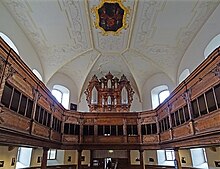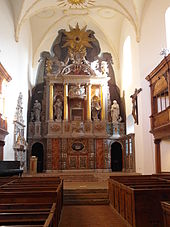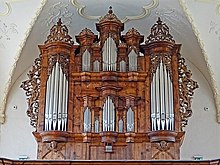St. Blasii (Quedlinburg)
St. Blasii is a church building in Quedlinburg .
history
The first mention of St. Blasii can be found in a document from 1222. A previous building probably dates from the 10th century, remnants of it are in the current tower. This oldest church was replaced by a magnificent building in 1267, which stood until 1711. In that year, the church - with the exception of the tower - began to be remodeled in the Baroque style , which was completed in 1715. The middle field of the 1720-23 designed interior bears the painted coat of arms of the abbess Marie Elisabeth of Schleswig-Holstein-Gottorf . The pulpit altar on the two-story horseshoe gallery and the old church stalls are noteworthy in the interior, which is not very decorated today . The church is registered in the Quedlinburg monument register.
In 1702, the Quedlinburg master carpenter Gabriel Rühle built the belfry for the north tower , in whose frame the inscription GABRIEL RUHLE ZIMMERMAN 1702 is carved.
From 1762 Johann August Ephraim Goeze preached at this church . He was a brother of the theologian Johann Melchior Goeze , an opponent of Lessing . The Goeze family's mausoleum is located in the Marktkirchhof, opposite the St. Benedikti Church .
From 1841 to 1843, the Blasii cemetery was created to replace the abandoned inner-city cemetery of the church in front of the city gates . In 1911 a new rectory was built west of the church .
The church was extensively restored in the 1990s with the support of the German Foundation for Monument Protection , after it had not been used since 1952 and the structure of the building had deteriorated considerably since then. After the repair, the church is mainly used as a cultural venue for book readings and concerts.
The church entrance on Blasiistraße has a historical peculiarity: to the right and left of the portal there is an extensive occurrence of grooves and pans, as the stone dust obtained here was said to have a healing or blessing effect in popular belief in the Middle Ages.
organ
The organ was built in 1905 by Ernst Röver (Quedlinburg). The romantically arranged instrument is completely preserved except for the prospectus. It has 30 stops (pneumatic box drawers) on two manuals and a pedal. In the course of the renovation of St. Blasii, the instrument was extensively refurbished, with the prospect pipes also being reconstructed according to the original lengths.
|
|
|
||||||||||||||||||||||||||||||||||||||||||||||||||||||||||||||||||||||||||||||||||||||||||||||||||
- Coupling : manual and manual octave coupler, I / P, II / P
- Playing aids : Fixed combinations (p, mf, f, tutti), trigger, calcant
Preacher or pastor
- –1540: Johann Sturk
- 1540–1569: Johann Winnigstädt
- 1569–1573: Bruno Quinos
- 1573–1598: Georg Scholle
- 1599–1601: Johann Fügespan
- 1601–1611: Johann Weidling
- 1613-1624: Martin Wolff
- 1624–1636: Johann Halensleben
- 1636–1659: Wolfgang Lattermann
- 1659-1660: Carl Christian Oeding
- 1660–1665: Johann Ludwig Roelius
- 1665–1696: Heinrich Carstenius
- 1697–1705: Johann Conrad Schneider
- 1705–1714: Melchior Christian Stüven
- 1715–1719: Joachim Quenstedt
- 1719–1723: Justus Jacobus Schulze
- 1723–1760: Georg Christoph Vopelius
- 1761–1787: Johann August Ephraim Goetze
- 1787–1788: Johann Dieter Eggert
- 1788–1801: Heinrich Matthias August Cramer
- 1802–1825: Johann Heinrich Friedrich Meinecke
- 1825–1849: Johann Friedrich Huch (1818?)
- 1850–1882: Gustav Mager
- 1882-1909: Oskar Donath
- 1910–1931: Ernst Georg
1933 united as the second parish of St. Blasii-Benedikti
- 1934–1946: Friedrich Sack
- 1946–1962: Hans-Georg Fiedler
- 1964–1965: Ingrid Schwarz
- 1965–1972: Christiane Preidt
- 1972-1998: Arthur Wolf
literature
- Winfried Korf: Quedlinburg. Parish Church of St. Blasii . Friedrich Juergens Nachf., Quedlinburg 1996 ( Quedlinburg 1).
Individual evidence
- ↑ St. Blasii on denkmalschutz.de
- ↑ Hans-Hartmut Schauer, Quedlinburg, specialist workshop / world cultural heritage , Verlag Bauwesen Berlin 1999, ISBN 3-345-00676-6 , page 76
- ↑ More information on Ernst Röver and the Röver organ ( memento of November 6, 2014 in the Internet Archive ), as of December 8, 2011.
Web links
Coordinates: 51 ° 47 ′ 19.1 ″ N , 11 ° 8 ′ 25 ″ E



